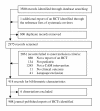Randomized controlled trials in pediatric complementary and alternative medicine: where can they be found?
- PMID: 12589711
- PMCID: PMC151673
- DOI: 10.1186/1471-2431-3-1
Randomized controlled trials in pediatric complementary and alternative medicine: where can they be found?
Abstract
Background: The safety and effectiveness of CAM interventions are of great relevance to pediatric health care providers. The objective of this study is to identify sources of reported randomized controlled trials (RCTs) in the field of pediatric complementary and alternative medicine (CAM).
Methods: Reports of RCTs were identified by searching Medline and 12 additional bibliographic databases and by reviewing the reference lists of previously identified pediatric CAM systematic reviews.
Results: We identified 908 reports of RCTs that included children under 18 and investigated a CAM therapy. Since 1965, there has been a steady growth in the number of these trials that are being published. The four journals that published the most reported RCTs are The American Journal of Clinical Nutrition, Pediatrics, Journal of Pediatrics, and Lancet. Medline, CAB Health, and Embase were the best database sources for identifying these studies; they indexed 93.2%, 58.4% and 42.2 % respectively of the journals publishing reports of pediatric CAM RCTs.
Conclusions: Those working or interested in the field of pediatric CAM should routinely search Medline, CAB Health and Embase for literature in the field. The four core journals identified above should be included in their collection.
Figures


Similar articles
-
A short guide to peer-reviewed, MEDLINE-indexed complementary and alternative medicine journals.Holist Nurs Pract. 2012 May-Jun;26(3):164-72. doi: 10.1097/HNP.0b013e31824ef4fd. Holist Nurs Pract. 2012. PMID: 22517352
-
The handsearching of 2 medical journals of Bahrain for reports of randomized controlled trials.Saudi Med J. 2006 Apr;27(4):526-30. Saudi Med J. 2006. PMID: 16598332
-
Bibliometric and content analysis of the Cochrane Complementary Medicine Field specialized register of controlled trials.Syst Rev. 2013 Jul 4;2:51. doi: 10.1186/2046-4053-2-51. Syst Rev. 2013. PMID: 23826877 Free PMC article.
-
An absence of pediatric randomized controlled trials in general medical journals, 1985-2004.J Clin Epidemiol. 2007 Feb;60(2):118-23. doi: 10.1016/j.jclinepi.2006.03.015. Epub 2006 Nov 13. J Clin Epidemiol. 2007. PMID: 17208117 Review.
-
Complementary and alternative medicine in the scientific literature.J Altern Complement Med. 2005 Feb;11(1):209-12. doi: 10.1089/acm.2005.11.209. J Altern Complement Med. 2005. PMID: 15750384 Review.
Cited by
-
Assessing the quality of reports of randomized trials in pediatric complementary and alternative medicine.BMC Pediatr. 2002;2:2. doi: 10.1186/1471-2431-2-2. Epub 2002 Feb 27. BMC Pediatr. 2002. PMID: 11914145 Free PMC article.
-
Children and natural health products: What a clinician should know.Paediatr Child Health. 2005 Apr;10(4):227-32. doi: 10.1093/pch/10.4.227. Paediatr Child Health. 2005. PMID: 19668621 Free PMC article. No abstract available.
-
Assessing the quality of reports of systematic reviews in pediatric complementary and alternative medicine.BMC Pediatr. 2002;2:3. doi: 10.1186/1471-2431-2-3. Epub 2002 Feb 27. BMC Pediatr. 2002. PMID: 11914146 Free PMC article.
-
Searching for controlled trials of complementary and alternative medicine: a comparison of 15 databases.Evid Based Complement Alternat Med. 2011;2011:858246. doi: 10.1093/ecam/nep038. Epub 2011 Jun 23. Evid Based Complement Alternat Med. 2011. PMID: 19468052 Free PMC article.
-
Importance of Modifiable Factors to Infant Health in the Context of Prenatal Opioid Use Disorder.J Addict Med. 2025 Mar-Apr 01;19(2):157-164. doi: 10.1097/ADM.0000000000001389. Epub 2024 Nov 8. J Addict Med. 2025. PMID: 39514901
References
-
- Panel on Definition and Description CRMCA1 Defining and describing complementary and alternative medicine. Alternative Therapies. 1997;3:49–57. - PubMed
-
- Ottolini MC, Hamburger EK, Loprieato JO, Coleman RH, Sachs HC, Madden R, et al. Complementary and alternative medicine use among children in the Washington, DC area. Ambul Pediatr. 2001;1:122–125. - PubMed
-
- Sawni-Sikand A, Schubiner H, Thomas RL. Use of complementary/alternative therapies among children in primary care pediatrics. Ambul Pediatr. 2002;2:99–103. - PubMed
MeSH terms
LinkOut - more resources
Full Text Sources
Medical

